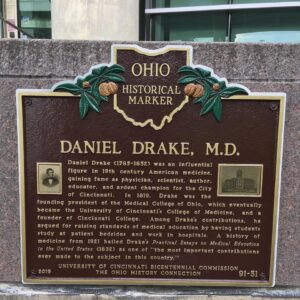, OH
In 1916, Bishop of Toledo Joseph Schrembs requested that the Sisters of Saint Francis, Rochester, Minnesota, send nuns to work with Polish immigrant children that were flooding into greater Toledo. Mother Mary Adelaide Sandusky (1874-1964) brought 22 sisters who quickly established a new order, their Toledo motherhouse, and began teaching in parish schools. Under her steady guidance, the Sisters of St. Francis of the Congregation of Our Lady of Lourdes, Sylvania, Ohio, transformed 89-acres of farmland into a tranquil campus that included gardens, shrines, and an arboretum. Mother Adelaide designed buildings modeled on the California missions and filled them with European art as well as original ceramic murals made by the Sisters. The Sylvania Franciscans flourished and over 500 new members joined between 1916 and 1964. (Continued on other side)
, OH
The Cozad-Bates House is one of the oldest remaining structures in Cleveland’s University Circle. The original section, built circa 1853, is the only pre-Civil War residential structure left in the neighborhood. Built by Samuel and Jane Cozad’s son, Andrew Cozad, the first section used locally made brick to form a simple two-story, one-room-deep, vernacular English-I house. The family owned a large portion of the land which is now occupied by University Circle. Justus Cozad, Andrew’s son, returning from the west where he worked as a railroad superintendent and civil engineer, built the later section on Mayfield Road for his larger family in 1872. It is a rare surviving example of Italianate-influenced residential architecture, including a hipped roof, curved bay windows, paired eave brackets, and prominent belvedere. The house was listed on the National Register of Historic Places in 1974 and designated as a Cleveland Landmark in 2006.
, OH
Daniel Drake, M.D.. Daniel Drake (1785-1852) was an influential figure in 19th century American medicine, gaining fame as physician, scientist, author, educator, and ardent champion for the City of Cincinnati. In 1819, Drake was the founding president of the Medical College of Ohio, which eventually became the University of Cincinnati’s College of Medicine, and a founder of Cincinnati College. Among Drake’s contributions, he argued for raising standards of medical education by having students study at patient bedsides and work in hospitals. A history of medicine from 1921 hailed Drake’s Practical Essays on Medical Education in the United States (1832) as one of “the most important contributions ever made to the subject in this country.”
, OH
The Harding Hospital, initially called the Columbus Rural Rest Home, was founded in 1916 by George T. Harding II, MD (1878-1934) and his associates, many of whom shared his commitment to service and his Seventh-day Adventist Christian faith. The psychiatic treatment center moved to Worthington in 1920. The hospital’s goal was to provide treatment with attention to the person’s physical, mental, social and spiritual needs. The program, with its emphasis on relational issues and psychotherapy, drew patients from across Ohio and beyond. In 1936 a residency program in psychiatry for physicians was started and educational programs for other mental health professionals followed. The campus’ beauty contributed to its being a place of healing for many. Since 1999, Harding Hospital has been a part of The Ohio State University’s Wexner Medical Center.
, OH
The Twenty-third Ohio Volunteer Infantry was the first Ohio regiment mustered for three years’ service in the Civil War, and also the first Ohio regiment in which the field officers were appointed by the governor of Ohio. Known as the “Regiment of Presidents,” the 23rd OVI had among its ranks several future politicians, including two future presidents: Commissary Sergeant William McKinley and Lieutenant Colonel Rutherford B. Hayes. The 23rd OVI suffered its greatest losses in the 1862 Antietam Campaign in the battles of South Mountain on September 14 and Antietam on September 17. While a large number of its wounded members, including Lieutenant Colonel Hayes, were lying in hospitals near the battlefields, the convalescing soldiers resolved to erect a regimental monument to the dead, and a subscription was started. (Continued on other side)






